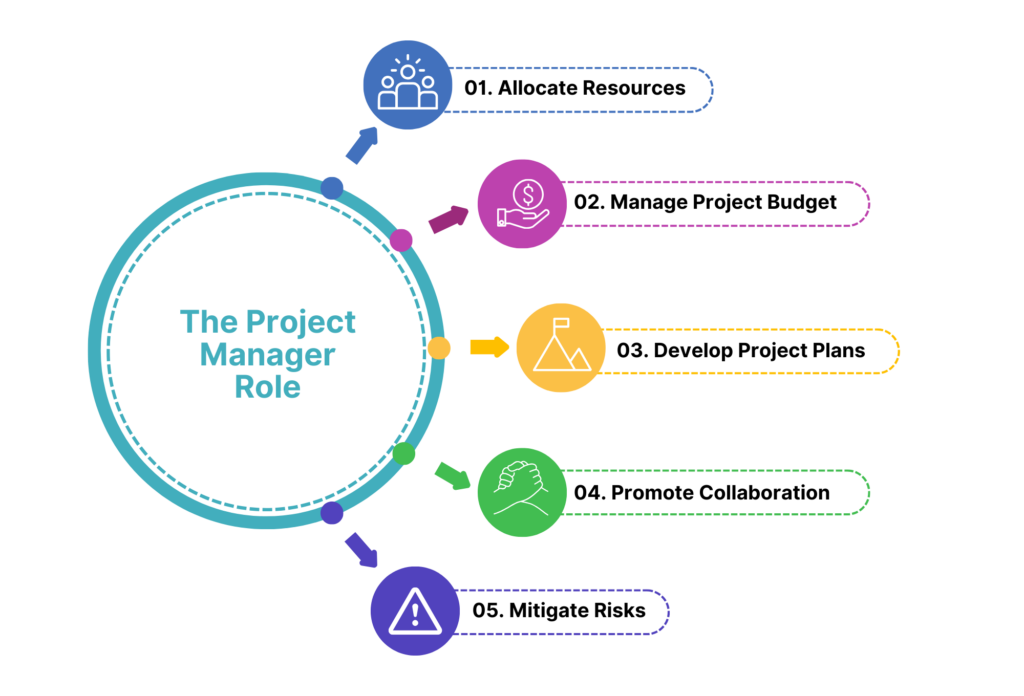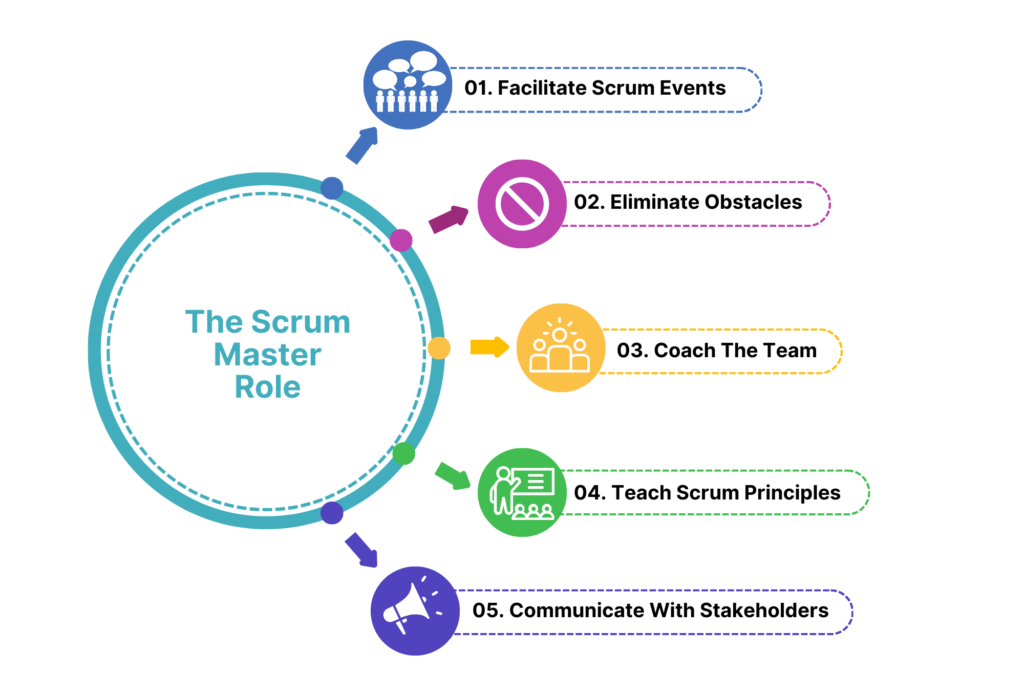The project manager and the scrum master have significant roles in project management. Even though these positions may appear similar, they have distinct characteristics and different functions to ensure project success.
The project manager oversees the entire project from its inception to completion. They are responsible for activities like planning, organizing, coordinating, and managing resources, budgets, and timelines. They are also skilled in risk management and problem-solving and ensure that the project stays on track and meets its objectives.
On the other hand, the scrum master is a coach who guides and supports the team. A scrum master facilitates the agile development process, promotes collaboration, and removes any obstacles that may affect progress. The scrum master ensures that the team follows the Scrum framework, enabling them to work efficiently and deliver results.
So, whether starting on a traditional or agile project, having the right leader can make all the difference.
Key characteristics of a traditional project manager
Effective project managers possess several key qualities. They are great leaders who know how to motivate their team and ensure everyone is working towards the same goal.
One of their top skills is communication, knowing how to convey information to different stakeholders and team members.
Moreover, a project manager has a strategic mindset and understands how the project fits into the organization’s overall objectives. This enables them to prioritize tasks and make informed decisions.
Lastly, project managers must be adaptable and flexible, as projects can often face unexpected challenges and changes. To ensure the project’s success, they need to be able to adjust their plans and strategies accordingly.
Responsibilities of a traditional project manager

Project managers work on developing detailed project plans and allocating resources effectively.
In addition, they need to closely monitor progress, identify and mitigate risks, and manage the project budget and timeline to ensure everything stays on track.
It’s also important for project managers to promote effective communication and collaboration among team members and stakeholders.
They act as the primary point of contact for all project-related questions and updates and work hard to resolve any conflicts that might arise.
Ultimately, their main focus is to lead, plan, organize, and manage resources to ensure that projects are completed successfully while staying within budget and timeline constraints.
The role of project managers in agile environments
Agile methodologies have certainly reshaped the role of project managers commonly linked with conventional waterfall project management methods.
Although the traditional command-and-control approach to project management may not perfectly align with the self-organizing, collaborative nature of agile teams, project managers can play a vital role in some agile environments.
Settings where project managers can be present in an Agile environment:
Large-Scale Projects
Large-scale agile projects involve multiple teams or complex dependencies. Here, project managers are essential in providing coordination, risk management, and team alignment.
Their responsibilities include ensuring that the project is on track, resolving any issues that may arise between teams, and efficiently managing interdependencies.
Hybrid Agile Environments
For companies moving towards agile methodologies or combining them with traditional project management approaches, project managers can play a crucial role in bridging the gap between agile teams and traditional stakeholders.
During such transitions, project managers can help explain agile concepts and practices to stakeholders who are not part of the agile teams and help them understand the language and processes used by the agile teams.
Regulated Industries
Project managers can implement agile practices that align with regulatory standards in sectors like healthcare, finance, or aerospace, which have stringent regulatory requirements or compliance standards.
An important part of their role is managing compliance issues, meeting documentation requirements, and ensuring that processes are followed meticulously.
Strategic Initiatives
The success of strategic initiatives that require long-term planning, cross-functional collaboration, and alignment with organizational goals heavily relies on the role of project managers.
Project managers ensure that the project objectives are defined, resources are allocated, and progress is tracked against strategic milestones in close collaboration with senior leadership, stakeholders, and agile teams.
Ultimately, the project manager’s oversight helps deliver value to the organization.
TIP: While agile methodologies emphasize self-organizing teams and decentralized decision-making, there are still contexts where project managers bring valuable skills and expertise to the table. The key is for project managers to adapt their approach to align with agile principles and support agile teams in effectively achieving their goals.
Key characteristics of a scrum master
A scrum master is an individual who plays a vital role in guiding a team of professionals working together to develop a product or service using an agile approach.
A proficient scrum master encourages cooperation and knowledge-sharing within the team, leading to continuous growth and learning.
Agile teams need an environment that fosters creativity and collaboration, and scrum masters are there to help their teams by empowering them to improve and create superior results.
Moreover, a scrum master is responsible for promoting effective teamwork. They ensure that the team members communicate effectively and share information.
They also liaise with external stakeholders to promote transparency and ensure that everyone involved understands the progress.
In doing so, they provide the team with the necessary information and resources to make appropriate decisions and deliver value to the customer.
The scrum master’s primary responsibility is to advocate for the Scrum framework and ensure that the team strictly adheres to its principles and practices while implementing agile methodologies.
In addition, the scrum master plays a critical role in keeping the team focused on delivering value to the customer and eliminating any obstacles that may affect progress.
Responsibilities of a scrum master

The Scrum Master is crucial in ensuring an Agile team’s smooth functioning.
They organize and conduct all Scrum events, including daily stand-ups, sprint planning, sprint reviews, and retrospectives.
Their objective is to ensure that everything runs efficiently and that the team adheres to Scrum principles.
The scrum master is a leader who supports the project team in various ways. One of their primary responsibilities is identifying and eliminating any obstacles that could impede progress, whether related to resources, processes, or interpersonal dynamics.
Additionally, they act as a coach, providing guidance and support to team members to help them reach their full potential.
If you are a beginner Scrum Master, read more in this article.
Can an agile team have a scrum master, a product owner, and a project manager working together?
A team may have a scrum master, product owner, and project manager, but their roles and responsibilities may vary based on the project’s context and the organization’s needs.
To illustrate, the scrum master would facilitate and coach the Scrum team, ensuring they follow Scrum practices, collaborate effectively, and self-organize to deliver value. Also falling in their responsibility would be removing obstacles that impede the team’s progress and facilitating Scrum events, such as daily stand-ups, sprint planning, sprint review, and sprint retrospectives.
On the other hand, the product owner will represent the stakeholders’ interests and ensure that the product backlog is prioritized based on business value. They will work closely with the stakeholders to gather requirements, define the product vision, and determine the features to include in each sprint. The product owner will also be responsible for maximizing the product’s value.
In such a setting, the project manager oversees the overall project, including budget, timeline, and resource allocation. They collaborate with the product owner to ensure project objectives align with business goals, manage risks, coordinate dependencies with other teams or projects, and communicate progress to stakeholders outside the Scrum team.
You can find out more about the collaboration between Product Owners and Scrum Masters here.
Final Thoughts
In conclusion, the project manager’s role may overlap with the Scrum Master or product owner in some organizations, where they work together to achieve project objectives.
Alternatively, the project manager may focus on higher-level project management activities while the scrum master and product owner focus on day-to-day execution within the Scrum framework.
Effective collaboration among these roles is crucial to ensure the project’s success. The specific distribution of responsibilities may vary depending on the organizational structure, project complexity, and team dynamics.

